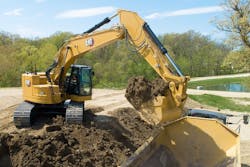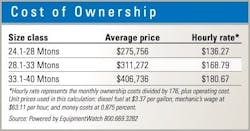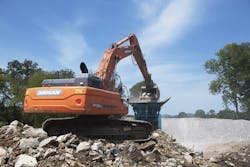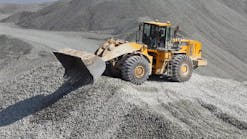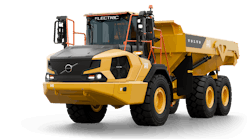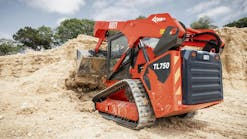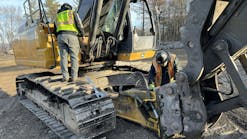“Performance, weight, and maneuverability are big factors when considering this class of excavators,” says Dave Donneral, specialized machine manager and assistant product development manager at KOBELCO. “Many of the larger minimum-tail-swing machines fall into this size category, and that is a constantly growing market. The machine must be strong enough to lift and load, but compact enough so you can work in tight quarters and operate in one lane of traffic.
“For customers doing a lot of dirt work and production digging, you want the ability to put large buckets on it like a 35-ton machine, but also have it easy to move without having to get expensive permits every time, like a 20-ton machine,” Donneral says. “It’s a balancing act to make sure the machine best fits your needs.”
The 60,000- to 80,000-pound size class is seeing a shift toward reduced-tail-swing units.
“One of the emerging trends with crawler excavators in this size class is the increased demand for a reduced-tail-swing machine,” says Aaron Kleingartner, then-product and dealer marketing manager for Doosan. “Typically, most reduced-tail-swing crawler excavators were found in smaller size classes, between 10 and 25 metric tons. That’s changing with some crawler excavator manufacturers offering a model with reduced tail swing.”
Kleingartner points out that Doosan will introduce a new DX350LCR-7 excavator with reduced tail swing to provide customers working in infrastructure and site development applications with a better-fitting machine for their job sites.
Choosing the right size for the job is important, but so is old-fashioned performance.
“One of the most important considerations in this size class is cycle times,” says Case Construction Equipment product manager Nathaniel Waldschmidt. “If that bucket isn’t full of material, that contractor is not making money.”
Case D Series excavators offer multiple working modes (Auto, Heavy, and Speed Priority) designed to provide a mix of power and fuel efficiency to match the needs of the application.
How to spec excavator buckets
Managers should also pay attention to bucket capacities and properly sized attachments.
Kurt Moncini, Komatsu’s senior product manager for excavators, says a quick rule of thumb is to size the excavator to load the target hauler in four to six passes.
“It’s a common misperception that bigger buckets are better for productivity,” Moncini says. “In many situations, a smaller bucket may outperform a bigger bucket when working in harder, more difficult-to-excavate materials by cycling faster. When upsizing buckets, it’s important to not exceed an excavator’s design parameters. Bigger, heavier buckets increase fuel consumption, create higher heat, more time over relief, and in the long run shorten machine life. Partial last passes with larger buckets are not efficient.”
For attachments such as breakers, crushers, and shears, Moncini recommends sizing them to the job requirements then back into the correct excavator size required to run the attachment. “AEM (Association of Equipment Manufacturers) manufacturers are very good at making excavator size recommendations for their attachments,” he says.
“Also, when required to handle objects on the job site, work with your dealer to make sure the published lifting charts match the lifting requirements,” Moncini says. “Pay special attention to over-the-side lift since it is controlled by machine stability.”
Caterpillar’s market professional Brian Stellbrink urges managers to consider the cost-effectiveness inherent in the latest equipment.
“Beyond performance-based requirements, one should also consider operating costs and the financial benefits of newer equipment with significantly lower fuel consumption and lower maintenance costs,” Stellbrink says. “For example, with some new mid-size Caterpillar next generation excavators, the fuel efficiency compared to previous models is up to 20 percent less. Maintenance costs can be up to 20 percent less. These two factors can have a significant impact on overall operating costs and help increase profitability.
“Some additional considerations are the available technologies to help increase efficiency on the job site,” Stellbrink says. “Last, but not least, a very important consideration is the dealer support.”
Once in the fleet, the focus becomes efficient operation with the lowest operating cost possible. Maintenance is a big key for cost reduction.
“Practice good diesel exhaust fluid practices,” Moncini says. “Keep your DEF clean, use DEF-only containers, and do everything possible to prevent DEF being added to engine, transmission, or hydraulic compartments.
“Also, always use manufacturer’s recommended grease, and lubricate pins as per manufacturer recommendations.” Moncini says. “If a pinned joint is making noise, it’s time to inspect and repair.”
Excavator undercarriage care
Managers should also pay attention to job site conditions and the effects terrain may have on a machine’s undercarriage.
“When working in high dust conditions, inspect and replace air filters more frequently,” Moncini says. “Do not clean dirty air filters with compressed air. High-pressure air can create holes in the filter paper, allowing dust to enter the engine.
“Inspect the undercarriage and maintain proper track tension,” Moncini continues. “When possible, always climb slopes with the sprockets to the rear and descend slopes with the sprockets forward to prevent the front idler spring compressing and potentially causing sprocket hopping.” Hose inspection should always be a part of general maintenance, Moncini says. “It’s cheaper to replace a worn hose during maintenance than having to do an unplanned repair on the job site.
“And watch your ground engaging tools. Don’t run a bucket without a tooth,” Moncini says. “Once an adapter wears, it’s extremely difficult to retain bucket teeth.”
In addition, use the machine’s available technology features to capture efficiencies.
“Don’t overlook economy mode power settings. They reduce hourly fuel cost when full performance is not required,” Moncini says. “Take advantage of telematics information to monitor machine health. Track idle time through Komtrax reports, and make use of auto idle shutdown to reduce nonproductive idle time.”
Stellbrink is also a big proponent of technology use. Cat has made it a focus to provide a core group of tech features as standard on certain models.
“Next generation excavators use a number of standard technologies to help the contractor achieve greater levels of productivity, enhanced safety, improved accuracy, and overall greater efficiency on the job,” he says. “The new advanced electro-hydraulic systems combine the electronic intelligence and flexibility with highly efficient hydraulic components. These enable key benefits such as lower fuel consumption, adjustable user control settings, feature upgrades, and automation.
“Smart hydraulics combined with advanced sensors and logic enable significant efficiency gains through the use of standard technologies such as Cat Grade, Cat Grade with Assist, Payload, and Lift Assist,” Stellbrink says. “The standard Grade technology helps operators achieve grade faster and with greater accuracy and without the risk of costly overdigging. The standard Payload technology prevents operators from overloading or underloading trucks, as well as tracking productivity whether truck loading, trenching, stockpiling, or other applications.”
Doosan’s latest technology for its Dash 7 excavators includes grade control and more. “These next-generation models will be available with an all-around view camera system,” Kleingartner says. “A second monitor inside the excavator cab will give operators an enhanced view of the work area. The system can help improve job site safety and reduce instances of the excavator making contact with other objects.”
Some Doosan excavators will be tiltrotator-ready,
as well. “Select models will be approved for use with tiltrotators for applications that can benefit from an expanded range of motion,” he says. “The enhanced machine versatility can provide more flexibility for operators and require less machine repositioning, saving operators time and increasing productivity.”
